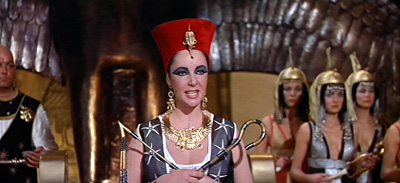March 05, 2007
Today's movie needs no introduction.

Cleopatra, 1963
This is the big one. Cleopatra is the most expensive American film ever made. Adjusted for inflation, it cost more to make than either Waterworld or Titanic. Only the Russian made War And Peace from 1968 cost more. The 44 million Cleopatra's producers spent by 1963 translates to over 285 million dollars today.
Cleopatra almost destroyed 20th Century Fox. For a time, it was the only movie in production from the studio. It's an example of how not to make a movie, if you want to save money. First, they completely rolled over for Elizabeth Taylor. Not only did they pay her million dollar asking price, with no counter-offer, they agreed to all her other demands including that it be made outside the U.S. When all was said and done (including a lawsuit filed by 20th Century Fox against Taylor and Burton) she ended up taking home 7 million.
Twentieth Century Fox originally started filming at Pinewood Studios in London, constructing a huge outdoor set of Alexandria. Taylor got sick (she almost died from pneumonia) and the production sat idle while she recuperated. They couldn't film because she was in mostly every scene. England's weather wouldn't cooperate either. It seems Rome and Alexandria in the fog just wasn't convincing enough for a big budget epic, so they finally destroyed the set and moved the production to Italy. By the time they were finished with it, cameras had rolled in England, Italy, Egypt and Spain.
Because of the delays, they also had to replace the original director and their two male leads, who got sick of waiting around doing nothing. Meanwhile, the script was written as the filming was going on, which required the production schedule to follow the script. That's not the most efficient use of sets and personnel because it requires that everybody stick around collecting paychecks, whether or not they're going to be used that day.
And the sets were extravagant. If you look at the details in the background, you can see they spared no expense. The gold leaf was real gold. Even the props were beautifully hand crafted. One minor actor had a sceptre made for him, which cost a shitload of money. After one rehearsal he said to director Joseph Mankiewicz "Joe, do I need this stick?" Mankiewicz said, "No, get rid of it." The actor later grumbled, "That's the trouble with this picture. It's full of such sticks." Another example — one of Elizabeth Taylor's 65 costumes was made out of spun gold.
Producer Walter Wanger (who did four months in jail for shooting a guy in the dick) seemed like the perfect guy to handle an iconic female biopic, since he made Queen Christina with Greta Garbo back in 1933. He wasn't up to the task. After Cleopatra, he never made another movie. Studio head Spyros Skouras was accused of cooking the books to hide the runaway spending from Fox's shareholders. When one accountant refused to cooperate, Skouras fired him and got one who would.
The scene in the YouTube video below is one of my favorites from the movie. Here Queen Cleopatra makes her triumphant entry into Rome with Caesarion at her side. It's a pretty good example of how the filmmakers spared absolutely no expense on this picture. There's no CG animation of course. So when you see Queen Cleopatra riding on a 50 foot sphinx being pulled by a hundred men through the Arch of Titus, she's really riding on a 50 foot sphinx being pulled by a hundred men through the Arch of Titus.* When they originally started filming this scene the shadows were unacceptable to DP Leon Shamroy, so they had to wait another six months before trying again.
Cleopatra is an incredible motion picture, as befitting an incredible woman, Cleopatra VII, the last Pharoah of Egypt. It's over four hours long (cut down from the original six hours) and even I couldn't watch it in one sitting. Its strengths include the spectacular pageantry, costumes and majestic score, which you can see and hear in the above YouTube clip. The battle scenes are great, and some of the matte paintings are indistinguishable from reality. The movie's weaknesses include the plodding script, which never seems to get into the character of its main subject. We learn a lot about what Cleopatra did, but we never really seem to get to know her.
By contrast, we learn that Marc Antony was kind of a loser, while Gaius Julius Caesar was a real winner. Rex Harrison (pre-Henry Higgins) was surprisingly convincing as the Dictator of Rome. Richard Burton, on the other hand, played Marc Antony as if he had just graduated from the William Shatner school of acting. For some reason, Burton's Roman skirt is about six inches too short throughout the movie. It looks silly, and his legs weren't that great.
In this next scene you can see the assassination of Julius Caesar through Cleopatra's eyes. Yes, that's Carol O'Connor sticking the first dagger in. (How fitting that Casca would be played by Archie Bunker.)
There are some great scenes that unfortunately I couldn't find on YouTube, including the one where Cleopatra has a public spat with Marc Antony, who comes to her seeking grain and an alliance.

Cleopatra: Without a treaty of alliance with Egypt, you could not hold the territories under your command. True?Oh, he kneels.Antony: Possibly.
Cleopatra: Then Lord Antony, you come before me as a suppliant.
Antony: If you choose to regard me as such.
Cleopatra: I do. You will therefore assume the position of a suppliant before this throne. You will kneel.
Antony: (incredulous) I will what?
Cleopatra: On... your... knees.
Antony: You dare ask the proconsul of the Roman Empire...
Cleopatra: (pissed) I asked it of Julius Caesar. I demand it of you.
Elizabeth Taylor's performance did not earn her an Oscar nomination, as Rex Harrison's did. She was inconsistent and seemed lost with such a big script. Some of this might not be her fault, of course. After she saw the film, Taylor complained that her best work had been edited out when Daryl Zanuck insisted that it be cut down to a manageable four hours.
When the real Cleopatra first met Caesar, after sneaking into his room in a rolled up carpet, she was only nineteen years old. She died at age 39, legend says from a self inflicted asp bite. Yet, Elizabeth Taylor never seems to grow in the film. Her nineteen year old Queen acts the same as her 39 year old Queen. Only the costumes are different.
The most fantastic scene for me was the depiction of the Battle of Actium. Roman history buffs know this was the naval battle off the coast of Greece between the forces of Octavian and the forces of Marc Antony, which ended the Roman Civil War and signaled the end of the Roman Republic. Watching the movie, I knew the ships were all models, but it's such an unfamiliar scene I found it believable.

I gave Cleopatra four Netflix stars (really liked it). I did really like it, even while I wished it could have been better. It's just so big, it's an accomplishment getting through the whole thing. And I feel like all the effort they put into such an epic does count for something, although it is ultimately unsatisfying. I suspect that if they ever find and restore all that lost footage, the original six hour version will probably be a lot better.
_______________
* Never mind that the Arch of Titus was built a hundred years after Cleopatra's death.
Posted by: annika at
07:43 PM
| Comments (15)
| Add Comment
Post contains 1310 words, total size 9 kb.
60 queries taking 0.0441 seconds, 142 records returned.
Powered by Minx 1.1.6c-pink.









